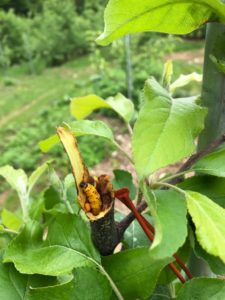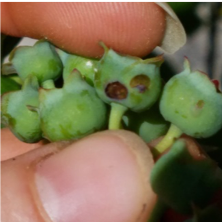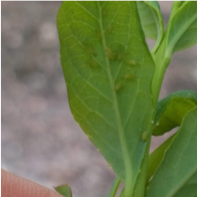Peach:
Plum Curculio (PC): PC oviposition continues in all areas of the state. We have seen increasing levels of damage, particularly in northern counties with up to 2-3% of fruit injury with egg scars. We have accumulated about 103 DD since petal fall (apple) in southern counties and just over 64 DD in Hunterdon County. The Cornell model calls for insecticides applied up to the 340 DD50 mark. This allows for the last of the PC activity to be covered by the residual from the last insecticide application. Therefore PC is still a primary target and needs to be controlled during the next couple of applications.
Tarnished Plant Bugs and Other Catfacing Insects: This is the other key insect complex at this time of year. Tarnished plant bugs will become more of an issue as temperatures warm and mowing and other ground cover activities become more common. General spray timing at this time of year should still be targeted for Oriental Fruit Moth and/or Plum Curculio (PC).
Oriental Fruit Moth: First generation timings are updated below:
| OFM 1st Degree Day (DD) Timing | ||||
| Insecticide Type | ||||
| County/Region | Biofix | DD by 5/13 base 45 | Conventional
170-200, 350-375 |
Diamide
100-150, 300-350 |
| Gloucester – Southern | 4/8 | 544
|
1st – past
2nd – past |
1st – past
2nd – past |
| Hunterdon – Northern | 4/16 | 327 | 1st – past
2nd – 5/16-18 |
1st – past
2nd – 5/11-13 |
Depending on the material being used, the second of 2 applications for the 1st generation is due now and over the weekend in northern counties. Insecticide applications are done for this generation in southern counties.
Scale Insects: White peach scale (WPS) crawlers begin to emerge yesterday and today (5/14-15), or about 2 weeks earlier than in a “normal” year. San Jose scale (SJS) crawlers usually begin emergence about a week later. If you have scale infestations on your trees, it is important to note if crawlers are present, even if you treated with oil in the early spring. If crawlers are present then treatment options include Esteem, Movento, Centaur, Venerate, and Diazinon. Esteem, Centaur, Venerate and Movento should be applied at the beginning of crawler emergence. Venerate needs to be applied at the low rate of 1 qt/A. Diazinon is labeled for only one post bloom or foliar application on stone fruit (Rec = max. of 2 lb/acre of the 50W). The apple label allows up to 2 foliar applications per year as long as a prebloom application was not made. The peach label allows 1 foliar application per year. Foliar applications may cause russet on apples, but has worked in the field for scale crawlers as long as applications are made 1-2 weeks after the start of crawler emergence and again 2 weeks later. Belay is also effective against scale crawlers but may need more than one application during the emergence which typically lasts about 4 weeks for WPS and 6 weeks for SJS.
Bacterial Spot: Maintain tight covers with antibiotics until pit hardening. Typical antibiotics used include various copper and oxytetracycline formulations. Leaf infections from 2 weeks ago are still present, but nothing is yet present on the fruit. This infection occurred prior to the developing fruit being exposed, so there is no danger to the fruit. However, when additional infections take place, using the leaf infections as an inoculum source, fruit does need to be protected. Full covers with at least 100 gpa are recommended.
Peach Scab: Maintain good coverage with captan or other effective fungicides until July, where scab was an issue last year.
Rusty Spot: Rusty spot infections are ongoing until pit hardening. Maintain coverage with effective materials such as Rally, Rhyme, or potassium bicarbonate products.
Brown Rot: Maintain coverage with effective materials until pit hardening. Do not rely on sulfur alone unless a dry weather pattern develops.
Apple:
Codling Moth (CM): The first codling moth flight has started. A biofix was set for CM on April 25th in southern counties and on May 1 in Hunterdon County.
| Codling Moth Degree Day Timing | ||||||||
| Application and Insecticide Type | ||||||||
| County Area | Biofix | Rimon:
75-100DD + 14-17 days later
|
Intrepid
150 + 450 DD Diamides – Altacor, Voliam mixes: (150-200 DD) + 14-21 days later |
Cyd-X, Madex
250 DD + every 7-9 days during brood hatch (later if first spray is an IGR) |
Standard Insecticides – Delegate, Avaunt, OP’s, carbamates, pyrethroids
250 DD + 550 DD
|
|||
| DD | 75 | 100 | 150 | 450 | 250 | 250 | 550 | |
| Southern | April 25 | past | past | past | Too far off | 5/18 | 5/18 | Too far off |
| Northern | May 1 | past | 5/9 | 5/19 | Too far off | 5/23 | 5/23 | Too far off |
Tufted Apple Budmoth (TABM): A biofix for TABM was set in southern county orchards on 4/25. Nothing needs to be done for TABM at this point. The first alternate middle applications for TABM will be on or about 5/23 in southern counties. This has been considered a minor pest in recent years.
European Apple Sawfly (EAS): In far northern counties, there is still time for a control application. We have seen EAS damage where no petal fall spray was used. On most commercial farms the petal fall spray is one of the most important applications a grower will make.
Diseases: Apple Scab, Powdery Mildew, Cedar Apple Rust, are diseases of concern at this time. The NEWA scab models are predicting about 100% ascospore maturity by 5/13 in southern counties and 95% maturity in northern counties (Pittstown). With 1 more rain event (min – .1 inch), the remaining spores should be released, marking the end of the primary infection period. The primary scab phase should be complete in southern counties. Cedar apple rust infections can occur anytime between pink and 3rd cover.
Fire Blight: A low incidence of Fire Blight symptoms were found in a two southern county orchards last week. Management practices for blocks with Fire Blight are outlined in the fact sheet “An Annual Fire Blight Management Program for Apples”. See last week’s newsletter for more management recommendations.
Leopard Moth: Several sites were seen last year and this past week with leopard moth activity. This is a fairly large spotted larva and can easily kill young branches or even larger 2-3” diameter wood. The larvae can be in the wood for as long as 2-3 years. This insect has a single generation per year, but a very long emergence and egg laying period. Insecticides can by used during egg laying to kill emerging larvae, but this is marginal at best, since the emergence period is so long. If you are spraying for other pests, and still have leopard moth issues, please let us know.

Figure 1. Leopard moth larva in apple branch. Photo – A. Atanassov.
Scouting Calendar Tree Fruit Southern Counties
The following table is intended as an aid for orchard scouting. It should not be used to time pesticide applications. Median dates for pest events and crop phenology are displayed. These dates are compiled from observations made since 1995 in Gloucester County. Events in northern New Jersey should occur 7-10 days later.
| Pest Event or Growth Stage | Approximate Date | 2019 Observed Date |
| Bud Swell (Redhaven) | March 23 +/- 15 Days | March 25 |
| 1/4″ Green Tip Red Delicious | March 31 +/- 13 Days | March 27 |
| Pink Peach (Redhaven) | April 4 +/- 15 Days | April 4 |
| Tight Cluster Red Delicious | April 9 +/- 13 Days | April 8 |
| Oriental Fruit Moth Biofix | April 9 +/- 13 Days | April 8 |
| Full Bloom Peach (Redhaven) | April 9 +/- 14 Days | April 9 |
| Pink Apple (Red Delicious) | April 14 +/- 12 Days | April 16 |
| Codling Moth Biofix | April 27 +/- 13 Days | April 25 |
| Green Peach Aphid Observed | April 16 +/- 16 Days | Not yet observed |
| Full Bloom Apple (Red Delicious) | April 22 +/- 11 Days | April 20 |
| Petal Fall (Redhaven) | April 22 +/- 10 Days | April 19 |
| Petal Fall (Red Delicious) | April 27 +/- 14 Days | April 29 |
| Shuck Split (Redhaven) | April 30+/- 11 Days | April 24 |
| First PC Oviposition Scars Observed | May 3 +/- 18 Days | April 23 |
| Tufted Apple Bud Moth Biofix | May 4 +/- 10 Days | April 8 |
| San Jose Scale Crawlers | June 2 +/- 8 Days | Not yet observed |
| Pit Hardening Peach | June 16 +/- 8 Days | Not yet observed |
Tree Fruit Trap Counts – Southern Counties
| Weekending | STLM | TABM-A | CM | AM | OFM-A | DWB | OFM-P | TABM-P | LPTB | PTB |
| 4/27 | 8 | 1 | 3 | 110 | 29 | 0 | ||||
| 5/4 | 4 | 5 | 6 | 34 | 17 | 1 | 0 | |||
| 5/11 | 2 | 8 | 5 | 31 | 5 | 5 | 0 |
Tree Fruit Trap Counts – Northern Counties
| Weekending | STLM | TABM-A | CM | AM | OFM-A | DWB | OBLR | OFM-P | TABM-P | LPTB | PTB |
| 4/6 | 0.3 | ||||||||||
| 4/13 | 2 | ||||||||||
| 4/20 | 10 | 0 | 0.2 | 0.9 | |||||||
| 4/27 | 9 | 0 | 0 | 4 | 9.5 | 0 | |||||
| 5/4 | 9 | 0.1 | 0.2 | 7 | 0 | 0 | 17.1 | 0.2 | 0 | ||
| 5/11 | 10 | 0.6 | 1.2 | 4 | 0 | 0 | 5.8 | 2 | 2.5 | 0 |
Blueberry
Plum Curculio (PC) – PC adult counts decreased some, probably due to the colder temperatures that inhibit adult activity. This week’s average for PC adults was 0.04 per bush with a maximum of 0.6 per bush. Adults have been and will continue to lay eggs until they are controlled. With respect to early fruit injury, this past week’s average was 0.15% of injury to fruit with a maximum of 1.4 % injured fruit. If nothing was done, we assume that most of this injured fruit (aside from chewing injury) already contain young larvae.
Therefore, this is the main insect pest to control at this time. The first post pollination spray should be the “work horse” for PC control. Some PC will continue to come in from border areas after this spray, but this application is the main one for PC control. The 2 strongest materials for PC include Imidan and Avaunt. If you are exporting fruit to Canada, or the United Kingdom / EU, you must watch the MRL issue. For Imidan (phosmet) use and U.S. consumption you can apply up to 5 applications (5 lb a.i.) per season and a 3 day PHI. The Canadian label has a 15 day PHI and a maximum of 2 applications per season. The MRL for Canada is 5 ppm, which can be easily met even with more than 1 application, but probably more than the 3 day PHI. The MRLs for the EU are all 10 ppm, or the same as in the U.S. Avaunt has a 1.5 ppm in the U.S., a .1 ppm in Canada, and a .8 ppm level in the UK/EU. Avaunt is registered in the EU, but not on blueberries. In the US it is registered for up to 4 applications per season on blueberries, with a 7 day PHI. So this makes it almost impossible to use if you are shipping to Canada, but OK for shipping to the UK/EU with 1-2 early applications. However, if you might ship to Canada, forget the Avaunt and go with the Imidan. As a general rule pyrethroids are weaker than Imidan on PC. Lannate is also not recommended, since it is weak on PC. Exirel is also not particularly strong on this pest, and is better saved for later applications. Anything used for PC control will also control any leafroller larvae and cranberry fruitworm.

Figure 2. PC damage at first post pollination. Photo – C. Denson.
Leafroller (LR), Other Lep. and Gypsy Moth (GM) Larvae: Numbers of leafroller larvae and other non-gypsy moth remained close to the same levels as during the previous week, averaging 0.04 per bush with a maximum of 0.6 larvae per bush. An average of only .05% of growing shoots can be found with Lep. larvae. We are still finding a minimal amount of gypsy moth throughout Burlington and Atlantic County. This week’s average for GM was 0.004 with a maximum of 0.2 larvae per bush. All sampling shows numbers below the treatment threshold of 1 larva per bush.
Aphids: Aphids are starting early this year, but were probably slowed down by the recent cool weather. We started to see aphids on the lower shoots this past week. Average infestation levels were 1.6% of shoots infested with a maximum 14% in 1 case. Colony sizes were at a minimal of 1 aphid per shoot. Therefore this can be watched, but should not be targeted at this time, especially at the expense of good PC control.

Figure 3. Young aphid colony on blueberry leaf. Photo – C. Denson.

